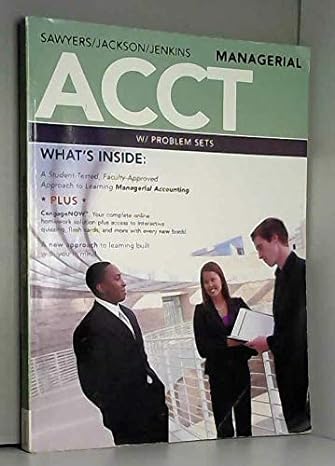Answered step by step
Verified Expert Solution
Question
1 Approved Answer
1. All of the following are ADVANTAGES of decentralization EXCEPT: A. Managers make better decisions when closer to the operation of the company. B. Each
1. All of the following are ADVANTAGES of decentralization EXCEPT: A. Managers make better decisions when closer to the operation of the company. B. Each decentralized operation purchases their own assets and pays for operating costs. C. Expertise in all areas of the business is difficult, decentralization makes it better to delegate certain responsibilities. D. Dencentralized managers can respond quickly to customer satisfaction and quality 2. In a profit center, the department manager has responsibility for and the authority to make decisions that affect: A. costs and assets invested in the center, but not revenues B. the assets invested in the center, but not costs and revenues C. both costs and revenues for the department or division D. not only costs and revenues, but also assets invested in the center 3.Some organizations use internal service departments to provide like services to several divisions or departments within an organization. Which of the following would probably not lend itself as a service department? A. human resources B. inventory control C. payroll accounting D. information systems 4. Espinosa Corp. had $1,045,293.00 in invested asstes, sales of $1,287,615.00, income from operations amounitng to $216,824.00, and a desired minimum rateof return of 14%. What is the residual income for Stevenson? A.$1,070,791 B. $216,824 C. $70,483 D. $146,341 5.A responsibility center in which the department manager is responsible for costs, revenues, and assets for a department is called: A. a cost center B a profit center C. an investment center D. an operating center 6. Division Q for Mott Co. has a rate of return on investment turnover of $2.32. What is the profit margin A. 29.00% B. 12.50% C.28.00% D. 2.32% 7. The balanced scorecard measures financial and nonfinancial performance of a business. The balanced scorecard measures four areas. Identify one of the following that is not includedas a performance measurement. A. internal process B. innovation and learning C. financial D. employees 8. Determining the transfer price as the price at which the product or services transferred could be sold to outside buyers is known as the: A. market price approach B. cost price approach C. revenue price approach D. negotiated price approach 9.The amount of increase or decrease in revenue that is expected from a particular course of action as compared with an alternative is termed: A. manufacturing margin B. differential cost C. contribution margin D. differential revenue 10. A cost will not be affected by later decisions is termed as A. historical cost B differential cost C. replacement cost D. sunk cost 11. The amonut of income that would result from an alternative use of cash is called: A. differential revenue B. differential income C. sunk cost D. opportunity cost 12. Jones Co. can futher process Product B to produce Product C. Product B is currently elling for $31.00 per pound and costs $28.00 per pound to produce. Product C would sell for $62.00 per pound and would require an additional cost of $24.00 per pound. Determine the differential cost of producing Product C. A $24.00 per pound B $28.00 per pound C $31.00 per pound D $62.00 per pound 13 Relevant revenues nd costs focus on: a. activities that occured in the past B. monies already earned and/or spent C last year's net income D. differences between the alternatives being considered 14. Win Co. produces a single product. Its normal selling price is $26.00 per unit. The variable costs are $16.00 per unit. Fixed costs are $20,549.00 for a normal production run of 5,000 units per month. Win received a request for a special order that would not interfere with normal sales. The order was for 1,657 units and a special price of $19.00 per unit. Win Co. has the capacity to handle the special order and, for this order, a variable selling cost of $2 per unit would be elimated A. increase of $8,285.00 B decrease of $11,599.00 C. increase of $36,258.06 D. increase of $31,483.00 15.Discontinuing a product or segment is a huge decision that must be carefully analyzed. WHICH OF THE FOLLOWING WOULD BE A VALID REASON NOT TO DISCONTINUE AN OPERATION? a. THE ALLOCATED FIXED COSTS ARE MORE THAN REVENUES b. THE VARIABLE COSTS ARE MORE THAN REVENUES c. the losses are minimal D. the variable costs are less than revenues 16. All of the following should be considered in a make or buy decesion except A. future growth in the plant and other production opportunities B.quality issues with the supplier C. the supplier will make profit that would no longer belong to the business D. cost savings 17. When using the total cost concept of applying the cost-plus approach pricing, what is included in the markup? A. total costs plus desired profit B. desired profit C. total fixed manufacturing costs, total fixed selling and administrative expenses, and desired profit D. total selling and administrative expenses plus desired profit
Step by Step Solution
There are 3 Steps involved in it
Step: 1

Get Instant Access to Expert-Tailored Solutions
See step-by-step solutions with expert insights and AI powered tools for academic success
Step: 2

Step: 3

Ace Your Homework with AI
Get the answers you need in no time with our AI-driven, step-by-step assistance
Get Started


